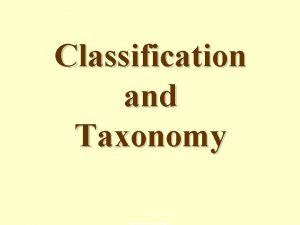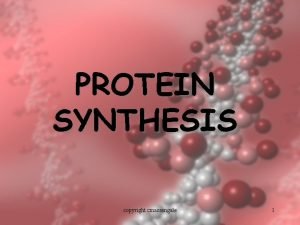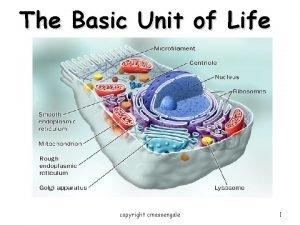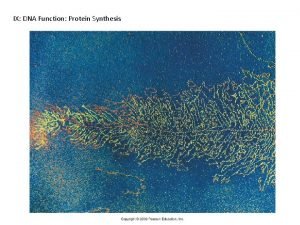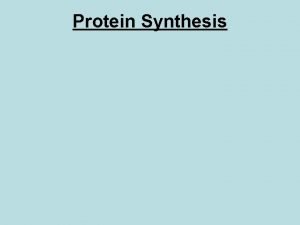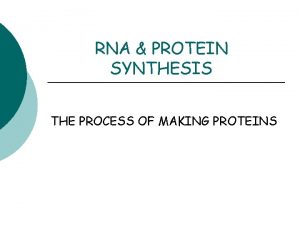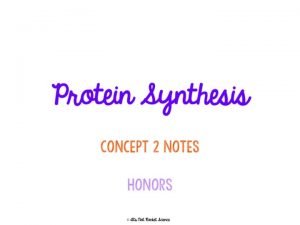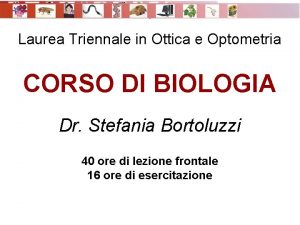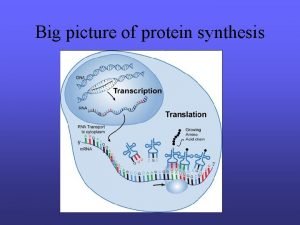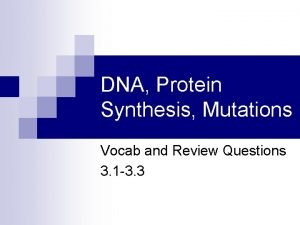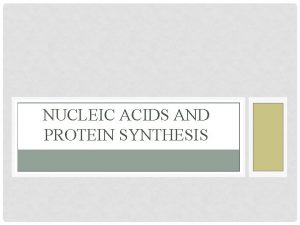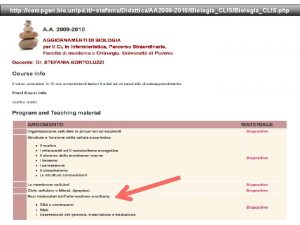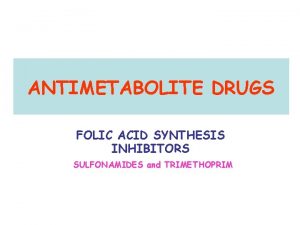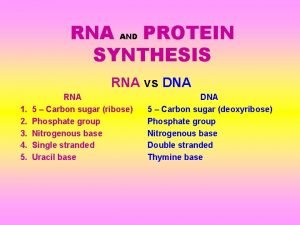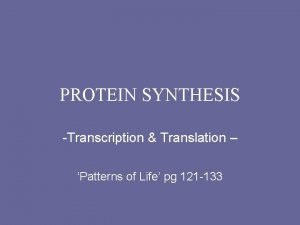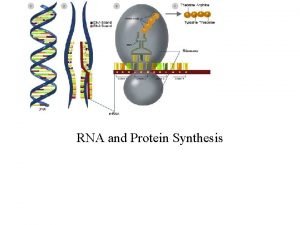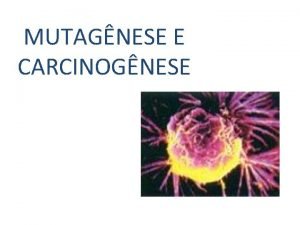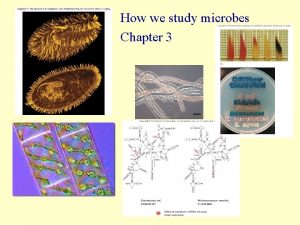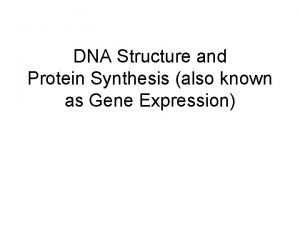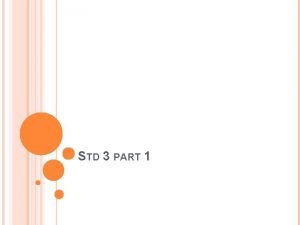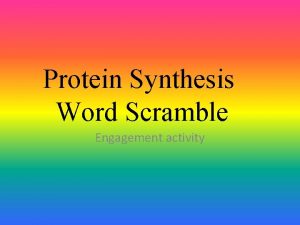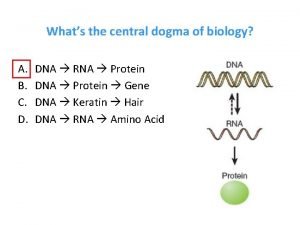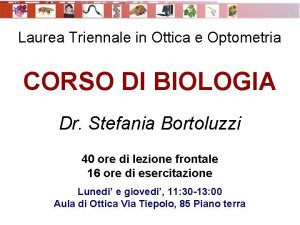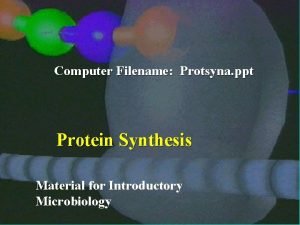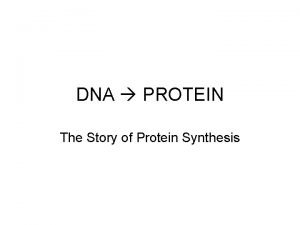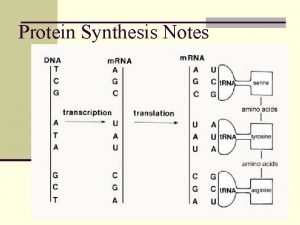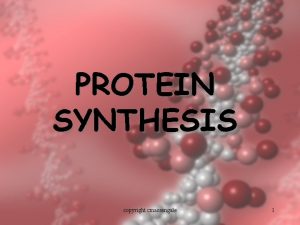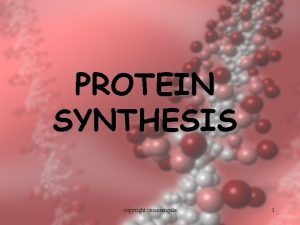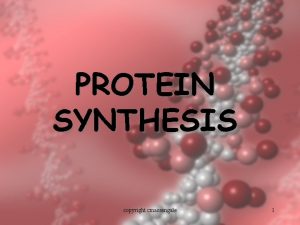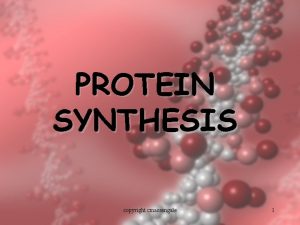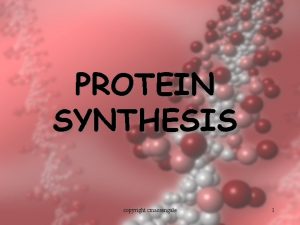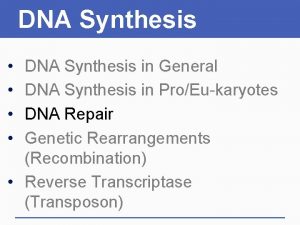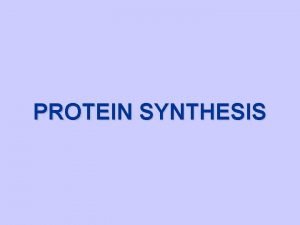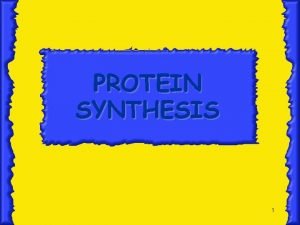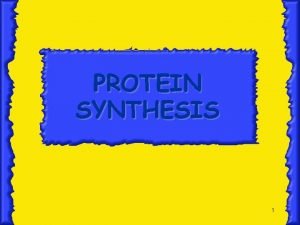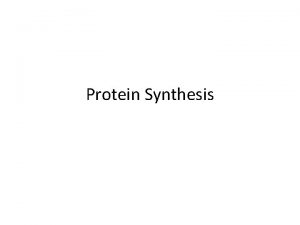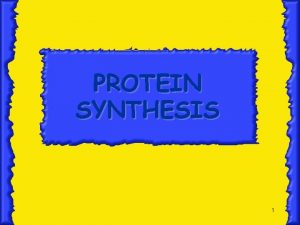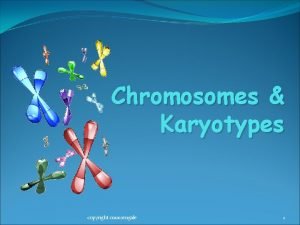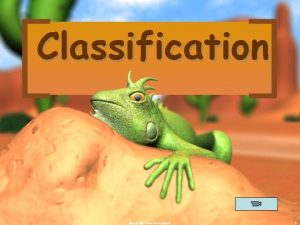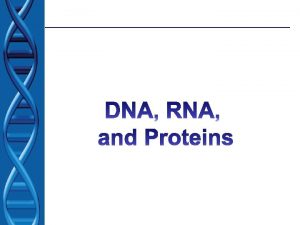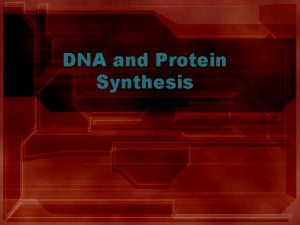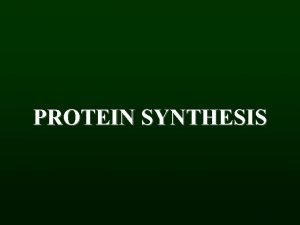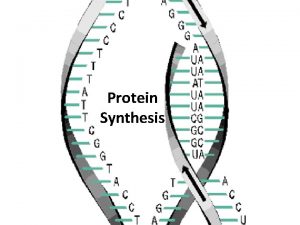PROTEIN SYNTHESIS copyright cmassengale 1 DNA DNA contains













































- Slides: 45

PROTEIN SYNTHESIS copyright cmassengale 1

DNA • DNA contains genes, sequences of nucleotide bases • These Genes code for polypeptides (proteins) • Proteins are used to build cells and do much of the work inside cells copyright cmassengale 2

Amino Acid Structure copyright cmassengale 3

Polypeptides • Amino acid chains are called polypeptides copyright cmassengale 4

Starting with DNA • DNA ‘s code must be copied and taken to the cytosol • In the cytoplasm, this code must be read so amino acids can be assembled to make polypeptides (proteins) • This process is called PROTEIN SYNTHESIS copyright cmassengale 5

Pathway to Making a Protein DNA m. RNA Read by ribosomes Protein copyright cmassengale 6

DNA RNA Protein Eukaryotic Cell Nuclear membrane DNA Transcription Pre-m. RNA Processing m. RNA Ribosome Translation Protein copyright cmassengale 7

RNA copyright cmassengale 8

Differences between DNA and RNA Nucleic Sugar Base Strands Acid DNA Deoxyrib A, C, G, Double ose Thymine RNA Ribose A, C, G, Uracil copyright cmassengale Single 9

Structure of RNA copyright cmassengale 10

. Three Types of RNA • Ribosomal RNA (r. RNA), along with protein, makes up the ribosomes • Messenger RNA (m. RNA) copies DNA’s code & carries the genetic information to the ribosomes • Transfer RNA (t. RNA) transfers amino acids to the ribosomes where proteins are synthesized copyright cmassengale 11

Ribosomal RNA (r. RNA) • r. RNA is a single strand 100 to 3000 nucleotides long • Globular in shape • Made inside the nucleus of a cell and exported to cytoplasm • Associates with proteins to form ribosomes • Site of protein Synthesis copyright cmassengale 12

Messenger RNA • Long Straight chain of Nucleotides • Copies DNA and carries the information for a specific protein • Made up of 500 to 1000+ nucleotides long, organized into 3 -base codons copyright cmassengale 13

Remember the Complementary Bases On DNA: A-T C-G On RNA: A-U C-G copyright cmassengale 14

Genetic Code § DNA contains a triplet code § Every three bases on DNA stands for ONE amino acid § Each three-letter unit on m. RNA is called a codon § Most amino acids have more than one codon! § 20 amino acids: 64 different triplets § ALL organisms use the SAME code 15

The Genetic Code • Example: AUG codes for Methionine 16

copyright cmassengale 17

Transfer RNA (t. RNA) • Clover-leaf shape • Single stranded molecule with attachment site at one end for an amino acid • Opposite end has three nucleotide bases called the anticodon copyright cmassengale 18

Transfer RNA amino acid attachment site U A C anticodon copyright cmassengale 19

Codons and Anticodons • The 3 bases of an anticodon are complementary to the 3 bases of a codon • Example: Codon ACU Anticodon UGA copyright cmassengale UGA ACU 20

RNA Ad • You are part of a marketing team tasked with designing a half page ad to sell RNA. You need to have a picture and slogan that will sell at least one of the types of RNA to consumers by showcasing its unique properties. • Underneath your ad, write 3 -5 sentences explaining how your ad will sell RNA. copyright cmassengale 21

Two Parts of Protein Synthesis § Transcription makes an RNA molecule complementary to a portion of DNA § Translation occurs when the sequence of bases of m. RNA DIRECTS the sequence of amino acids in a polypeptide 22

Transcription Translation 23

Transcription • The process of copying the sequence of one strand of DNA, the template strand • m. RNA copies the template strand • Requires the enzyme RNA Polymerase copyright cmassengale 24

Template Strand copyright cmassengale 25

Question: § What would be the complementary RNA strand for the following DNA sequence? DNA 5’-GCGTATG-3’ copyright cmassengale 26

Answer: • DNA 5’-GCGTATG-3’ • RNA 3’-CGCAUAC-5’ copyright cmassengale 27

Transcription • During transcription, RNA polymerase binds to DNA and separates the DNA strands • RNA Polymerase then uses one strand of DNA as a template to assemble nucleotides into RNA copyright cmassengale 28

RNA Polymerase copyright cmassengale 29

m. RNA Transcript • m. RNA leaves the nucleus through its pores and goes to the ribosomes copyright cmassengale 30

Translation • Translation is the process of decoding the m. RNA into a polypeptide chain • Ribosomes read m. RNA three bases or 1 codon at a time and construct the proteins copyright cmassengale 31

Ribosomes • Made of a large and small subunit • Composed of r. RNA (40%) and proteins (60%) • Have two sites for t. RNA attachment --- P and A copyright cmassengale 32

Translation • Three steps: 1. initiation: m. RNA binds to ribosome at start codon (AUG) 2. elongation: amino acids linke 3. termination: stop codon (UAG, UAA, or UGA) signals ribosome to release m. RNA 33

Step 1 - Initiation • m. RNA transcript attaches to the small ribosomal subunit • Small subunit attaches to large ribosomal subunit m. RNA transcript copyright cmassengale 34

Ribosomes Large subunit P Site A Site m. RNA Small subunit A U G C U A C U U C G copyright cmassengale 35

Initiation aa 2 aa 1 2 -t. RNA 1 -t. RNA anticodon hydrogen bonds U A C A U G codon G A U C U A C U U C G A copyright cmassengale m. RNA 36

Step 2 - Elongation • As ribosome moves, t. RNA with their amino acids move into the ribosome • Peptide bonds join the amino acids copyright cmassengale 37

Elongation peptide bond aa 1 aa 3 aa 2 3 -t. RNA 1 -t. RNA anticodon hydrogen bonds U A C A U G codon 2 -t. RNA G A U C U A C U U C G A copyright cmassengale m. RNA 38

aa 1 peptide bond aa 3 aa 2 1 -t. RNA 3 -t. RNA U A C (leaves) 2 -t. RNA A U G G A A G A U C U A C U U C G A m. RNA copyright cmassengale Ribosomes move over one codon 39

aa 1 peptide bonds aa 2 aa 4 aa 3 4 -t. RNA 2 -t. RNA A U G 3 -t. RNA G C U G A A C U U C G A A C U m. RNA copyright cmassengale 40

aa 1 peptide bonds aa 4 aa 2 aa 3 2 -t. RNA 4 -t. RNA G A U (leaves) 3 -t. RNA A U G G C U G A A C U U C G A A C U m. RNA copyright cmassengale Ribosomes move over one codon 41

aa 1 peptide bonds aa 5 aa 2 aa 3 aa 4 5 -t. RNA U G A 3 -t. RNA 4 -t. RNA G A A G C U A C U U C G A A C U m. RNA copyright cmassengale 42

peptide bonds aa 1 aa 5 aa 2 aa 3 aa 4 5 -t. RNA U G A 3 -t. RNA G A A 4 -t. RNA G C U A C U U C G A A C U m. RNA copyright cmassengale Ribosomes move over one codon 43

aa 4 aa 5 Termination aa 199 aa 3 primary structure aa 2 of a protein aa 200 aa 1 200 -t. RNA A C U terminator or stop codon C A U G U U U A G m. RNA copyright cmassengale 44

End Product –The Protein! • The end products of protein synthesis is a primary structure of a protein • A sequence of amino acid bonded together by peptide bonds aa 2 aa 1 aa 3 aa 4 aa 5 aa 199 copyright cmassengale aa 200 45
 Dna rna protein synthesis homework #2 dna replication
Dna rna protein synthesis homework #2 dna replication Copyright
Copyright Cmassengale
Cmassengale Cmassengale
Cmassengale Rna and protein synthesis study guide
Rna and protein synthesis study guide Catalytic functions
Catalytic functions Process of protein synthesis
Process of protein synthesis Concept map of protein synthesis
Concept map of protein synthesis Transcription and translation bbc bitesize
Transcription and translation bbc bitesize Translation biology
Translation biology Protein synthesis
Protein synthesis Protein synthesis
Protein synthesis Protein synthesis
Protein synthesis Picture of protein synthesis
Picture of protein synthesis Rna protein synthesis
Rna protein synthesis Protein synthesis and mutations
Protein synthesis and mutations Dna vs rna
Dna vs rna 4 steps of protein synthesis
4 steps of protein synthesis Ribonucleotide vs deoxyribonucleotide
Ribonucleotide vs deoxyribonucleotide Ribonucleic acid
Ribonucleic acid Protein synthesis
Protein synthesis Protein synthesis
Protein synthesis Protein synthesis inhibitor
Protein synthesis inhibitor Protein synthesis restaurant analogy
Protein synthesis restaurant analogy Protein synthesis
Protein synthesis Protein synthesis animation mcgraw hill
Protein synthesis animation mcgraw hill Section 12 3 rna and protein synthesis
Section 12 3 rna and protein synthesis Cookie monster analogy
Cookie monster analogy Protein synthesis
Protein synthesis Rna protein synthesis
Rna protein synthesis Ribosome
Ribosome Protein synthesis and mutations
Protein synthesis and mutations Double stranded dna
Double stranded dna Which best summarizes the process of protein synthesis?
Which best summarizes the process of protein synthesis? Translation or transcription
Translation or transcription Protein synthesis scramble
Protein synthesis scramble Pap protein synthesis worksheet
Pap protein synthesis worksheet Whats the central dogma of biology
Whats the central dogma of biology Sintese de proteinas na celula
Sintese de proteinas na celula Protein synthesis ppt
Protein synthesis ppt Section 12 3 rna and protein synthesis answers
Section 12 3 rna and protein synthesis answers Protein synthesis story
Protein synthesis story Protein-protein docking
Protein-protein docking Protein pump vs protein channel
Protein pump vs protein channel Unlike dna rna contains
Unlike dna rna contains This ameba would most likely be classified as a
This ameba would most likely be classified as a

